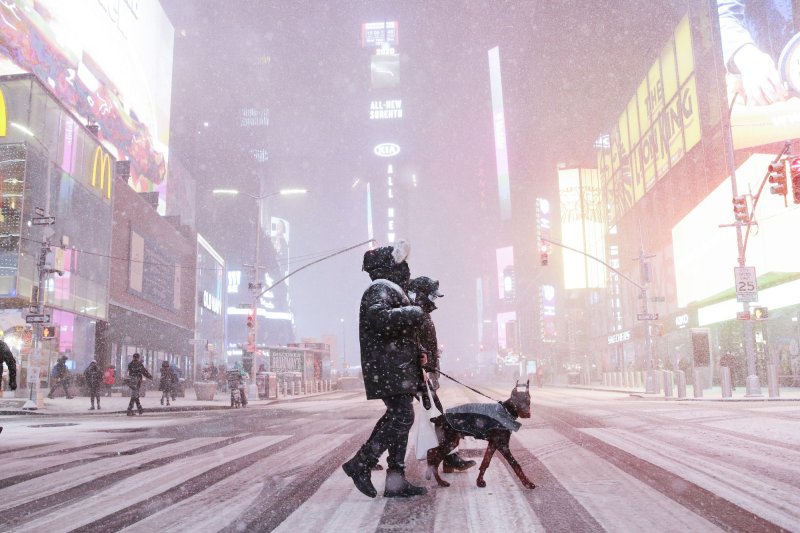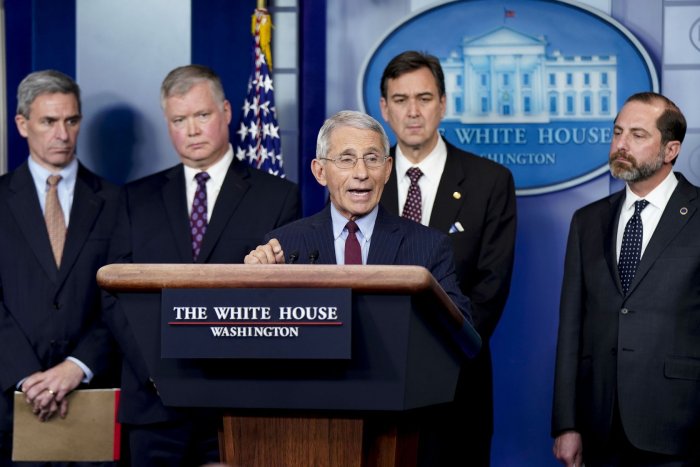Pedestrian traffic is scarce along 7th Avenue in during heavy snow in Times Square in New York City on December 16, 2020. Snowstorms this winter held up vaccine shipments and the rare winter freeze in Texas for a week also disrupted mitigation efforts. File Photo by John Angelillo/UPI |
License Photo
March 12 -- As the world marks one year since the World Health Organization designated the coronavirus outbreak a global threat, a look back at the past 12 months shows how much has been learned about how the virus is structured, how it spreads and how it behaves.
Yet some weighty questions linger -- mainly, how did we get here?
Many signs and data points suggest the weather may influence the coronavirus to some degree, but to what degree remains something of a mystery.
Since the world as we knew it ground to a halt last March, dozens (if not hundreds) of different studies have been published analyzing the many different weather influences on COVID-19. While each publication has shed some amount of new light on the topic, the overall picture remains murky at best.
However, as the end of winter nears, caseloads across the United States have gradually receded in recent weeks. Glimmers of hope twinkle that in the coming months, a mix of warmth and sunshine could offer the environmental aid needed to supplement human efforts at slowing and eventually stopping the transmission of the virus.
"It's tough to say exactly how big of a puzzle piece (seasonality) is, but I am personally looking forward to summer," researcher Jonathan Proctor told AccuWeather in January. "I have a little bit of optimism."
Proctor and his fellow authors from Harvard University and the University of California, Santa Barbara shared their findings on the impacts of seasonality on COVID-19 in December, and certainly weren't the first researchers to try to better understand the link.
Going all the way back to March 2020, experts were keenly aware that some specific weather conditions were likely to play some role in the pandemic's impact.
![]()
A bicyclist rests at the reflecting pool near the Washington Monument on the National Mall in Washington, D.C., on April 8, 2020. Many hoped that the warmer weather last summer would help drive the coronavirus away, but it didn't happen. Photo by Kevin Dietsch/UPI
Linsey Marr, an aerosol scientist at Virginia Tech University, explained to AccuWeather at the very beginning of the pandemic that the spread of coronavirus can be compared to second-hand smoke.
At the time, the United States hadn't yet seen a day with more than 10,000 new COVID-19 cases.
"I think as the weather warms up and our humidity indoors gets higher, we'll have to see. We can hope that transmission might slow down, but I don't think we can count on it," Marr said on March 23, 2020.
Marr's doubt proved fatally true. More than a half-million U.S. COVID-19 deaths later, it's been proven that human behavior perhaps plays a much larger role than environmental factors in influencing viral spread.
By July 2020, daily caseload increases were regularly topping 70,000, more than twice what they were just three months before. This rise also coincided with the United States significantly ramping up testing.
Come winter, when many environmental aids were replaced by a season of gray and snow, new cases had multiplied fourfold and topped out at about 300,000 new cases on Jan. 2, according to Johns Hopkins University. But was it just the weather that sent new infections surging?
Rising cases also coincided with the Thanksgiving and Christmas holidays, occasions in which many Americans ignored health officials' advice for holiday travel.
But untangling which forces -- weather conditions, government restrictions or human behavior -- are most dominant in this equation has proven highly difficult for researchers.
Comparing the size of impacts weather can make may be a nearly impossible task to quantify, but experts like Proctor and Bryan Lewis, a professor with the Biocomplexity Institute at the University of Virginia, say Americans need to stick to the basics first and then hope the helpful weather can help.
"COVID is kind of both really difficult and simple at the same time," Proctor said, advising that people "keep doing the basics of wearing a mask."
Lewis told AccuWeather in January that those basics have proven effective, as seen by the vast reduction of flu cases this winter. The seasonal flu, another virus that's largely influenced by weather, is spreading at record-low rates this winter -- and experts say mask-wearing and social distancing are the reason.
However, Lewis emphasizes, the flu and the coronavirus behave, spread and impact in much different ways.
The flu season typically runs from October to March, with some active cases lasting into May. But this year, it's just nowhere to be found, Lynette Brammer, who leads the domestic influenza team for the Centers for Disease Control and Prevention, told AccuWeather in February.
"The flu season this year has been pretty nonexistent," she said. "And I really do think that has a lot to do with the levels of precautions folks are taking, just the extra social distancing we're engaged in has eliminated flu transmission over this season."
"The flu has just been fully interrupted by people wearing masks, staying home, the reduced number of children in schools and I think more people got the flu vaccine."
![]()
Crews work to repair broken water lines in Wylie, Texas, during a rare winter storm on February 18. Record cold temperatures, snow and ice caused power outages and led to frozen water pipes. Photo by
Ian Halperin/UPI
The spread of vaccines, Lewis said, will be crucial for environmental benefits in slowing the coronavirus going forward.
President Joe Biden said Thursday night that vaccines will be available for every adult in the United States by the end of April, a timeline that would align nicely with the year's peak sunshine months of summer.
Biden said the vaccines represent a "light at the end of the tunnel," but cautioned Americans not to let down their guard.
The vaccine rollout process over the past three months has been difficult from a logistical standpoint. Adding to that, strictly in a practical sense, weather events certainly haven't helped.
Major snowstorms in Chicago, New York City and Philadelphia have held up vaccination efforts and the rare winter freeze that shut down Texas for a week also halted testing and vaccinations.
The environment can't be fully relied upon to kill COVID19, like some hoped a year ago, but basic protection efforts and increased vaccinations are causes for optimism.
"We have to just brace ourselves that there's a long way to go before we have sufficient vaccinations to induce herd immunity and allow us to go back to normal," Lewis said.
"Hopefully, by the time spring arrives and we get some assistance from Mother Nature, we'll be at a very low prevalence, and we then can start to move back into a normal life."
January 31, 2020
National Institutes of Health official Dr. Anthony Fauci (C) speaks about the coronavirus during a press briefing at the White House in Washington, D.C. Health and Human Services Secretary Alexander Azar (L) announced that the United States is declaring the virus a public health emergency and issued a federal quarantine order of 14 days for 195 Americans. Photo by Leigh Vogel/UPI |
License Photo


















